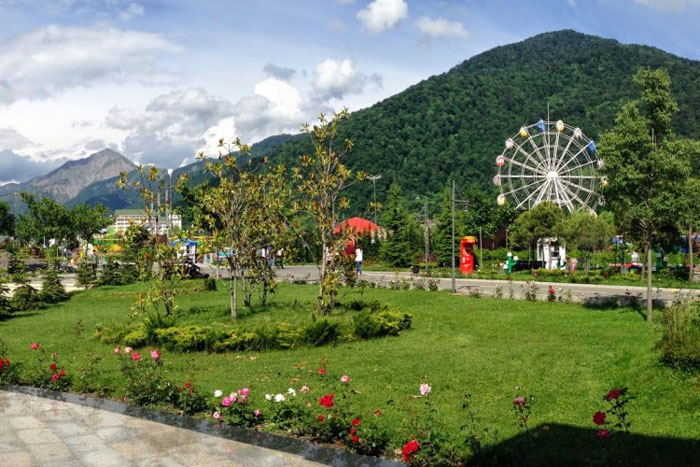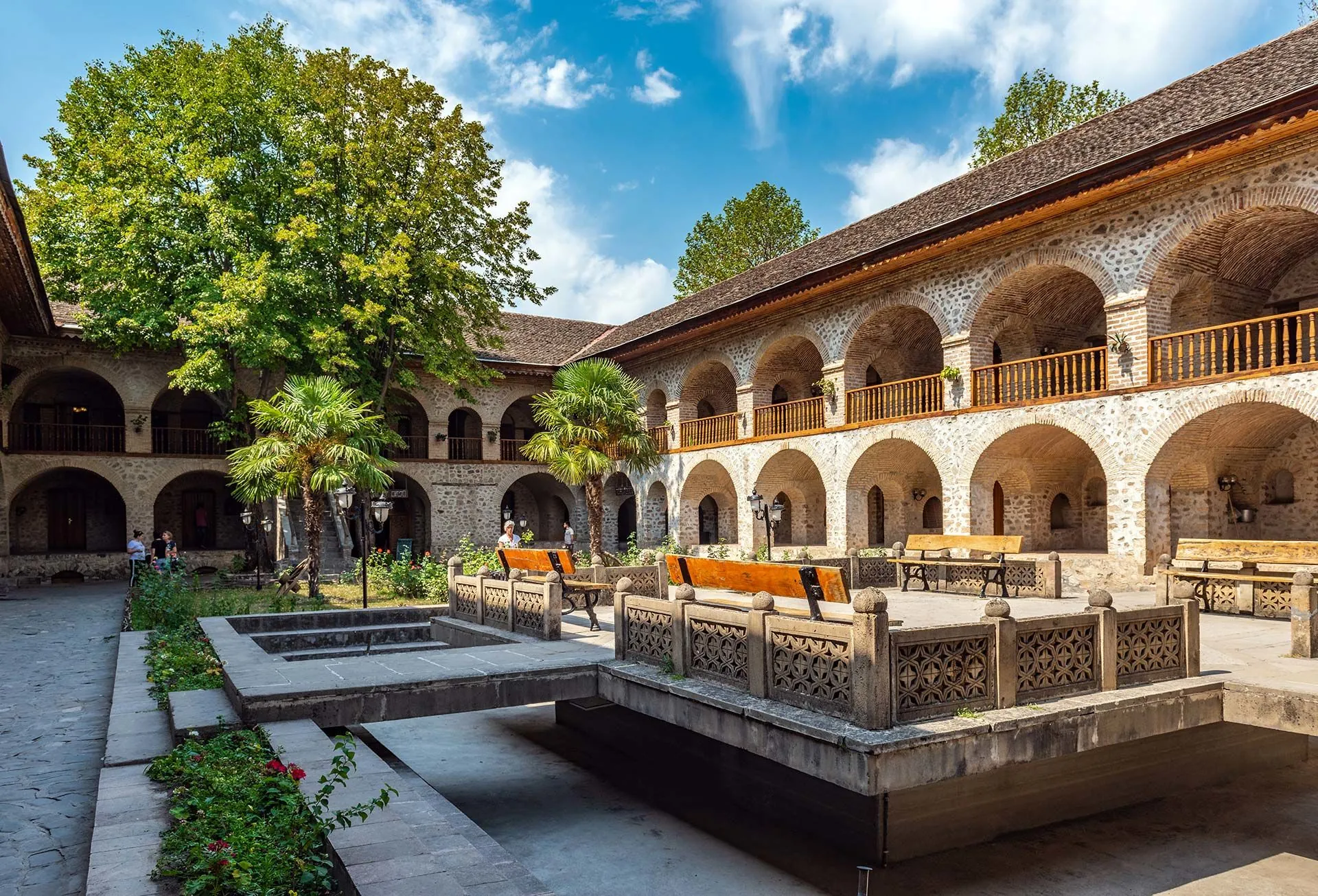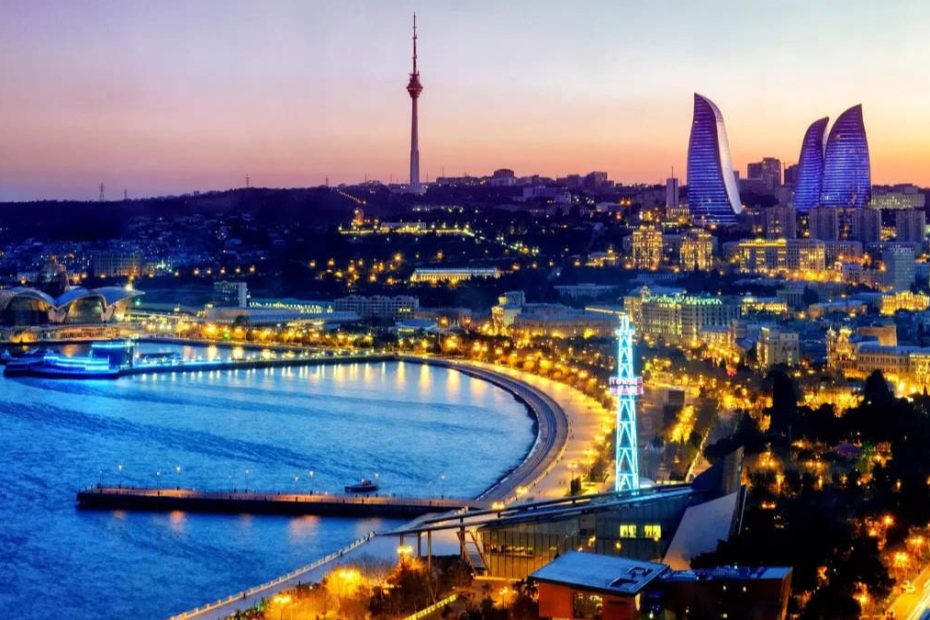Azerbaijan, often called the Land of Fire, offers a rich world of history, culture, and natural beauty. With just four days, you can immerse yourself in its vibrant cities, stunning landscapes, and unique traditions. Whether you’re wandering through the bustling streets of Baku or exploring the serene mountains of Gabala, every moment promises a new adventure.
Key Takeaways
- Rich Cultural and Historical Heritage: Azerbaijan, known as the Land of Fire, features ancient sites like Gobustan National Park and Sheki Khan’s Palace, showcasing its profound history and diverse cultural influences from its strategic location at the crossroads of Europe and Asia.
- Vibrant Capital – Baku: Baku offers a blend of historical and modern attractions, including the Old City, Maiden Tower, and contemporary landmarks like the Flame Towers and Heydar Aliyev Cultural Centre, making it a focal point for both history lovers and modern tourists.
- Diverse Natural Landscapes: The country’s varied landscapes, from the Caspian Sea coastline to the Caucasus Mountains, provide ample opportunities for outdoor activities like hiking, skiing, and exploring unique natural phenomena such as Yanar Dag.
- Unique Culinary Experiences: Azerbaijani cuisine, influenced by Persian, Turkish, and Russian flavors, includes must-try dishes like plov, dolma, and kebabs, offering a delectable exploration of its rich culinary traditions.
- Warm Hospitality: The Azerbaijani people are known for their friendliness and warmth, often inviting visitors into their homes for tea and sweets, enhancing the travel experience with genuine hospitality.
- Efficient Tourism Infrastructure: Increasing investments in tourism have improved amenities and transportation options across Azerbaijan, from luxury accommodations in Baku to charming guesthouses in the countryside, ensuring a comfortable journey for all types of travelers.

Overview Of Azerbaijan

Azerbaijan, at the crossroads of Eastern Europe and Southwestern Asia, borders Armenia and Turkey to the west, Iran to the south, Russia and Georgia to the north, and the Caspian Sea to the east. Its strategic location has sculpted a diverse culinary and cultural world influenced by its neighbors.
Rich Historical Heritage
Azerbaijan boasts a history that dates back thousands of years. Ancient petroglyphs in Gobustan, a UNESCO World Heritage Site, highlight the earliest human settlements. The architectural marvels of Sheki, including the Sheki Khan’s Palace with its intricate stained glass, showcase the country’s rich past.
Diverse Natural Landscapes
The country offers a collage of natural landscapes: the Caspian Sea coastline, the lush vineyards of the Caucasus Mountains, and the semi-desert plains. These diverse terrains support various outdoor activities, from hiking in the mountains to swimming in the Caspian.
Baku: The Heart Of Azerbaijan
Baku, the vibrant capital, merges historical allure with modern innovation. The second oil boom in 2006 transformed the city. Iconic landmarks like the Flame Towers and the historic Maiden Tower highlight Baku’s unique blend of old and new. The city’s waterfront, the Baku Boulevard, is perfect for evening strolls and capturing picturesque sunsets.
Unique Culinary Experiences
Azerbaijani cuisine mirrors its rich cultural interactions. Traditional dishes like plov (a seasoned rice dish), dolma (stuffed grape leaves), and kebabs are must-tries. Influences from Persia, Turkey, and Russia create a unique fusion that delights the palate. Sampling local cuisine is a vital part of the travel experience.
Warm Hospitality
Azerbaijani people are known for their warm hospitality. It’s common to be invited into homes for tea and sweets, even by strangers. This warmth extends to markets and shops, where visitors are greeted with genuine friendliness.
Growing Tourism Infrastructure
With increasing investments in tourism, Azerbaijan offers a range of modern amenities. From luxury hotels in Baku to charming guesthouses in the countryside, accommodation options cater to various preferences. Improved transportation networks make getting around the country easier and more comfortable.
Key Festivals And Events
Azerbaijan hosts vibrant festivals reflecting its rich cultural world. The Novruz Bayram, celebrating the Persian New Year, involves numerous traditional activities and culinary delights. The Formula 1 Azerbaijan Grand Prix in Baku draws international attention and showcases the city’s modernity.
Craft And Artistry
The nation’s heritage in arts and crafts adds another layer to its cultural richness. Craftsmanship in carpet weaving, which dates back centuries, reflects intricate designs and superior quality. Visitors can explore carpet museums and purchase handmade carpets as souvenirs.
Efficient Communication
While Azerbaijani is the official language, Russian and English are widely understood, especially in urban areas. Tourists find it relatively easy to communicate and navigate the region.
Exploring Azerbaijan reveals a land of contrasts and harmonies. Its history, nature, modernity, and traditions make it a captivating destination for diverse interests.
Day 1: Baku – The City Of Winds

Baku’s mix of ancient history and modern flair makes it an exciting city to explore. Start your day in the historical heart of the city and transition to its contemporary highlights.

Morning: Exploring The Old City
I begin my day in the Old City, a UNESCO World Heritage site filled with historical treasures. My first stop is the Palace of the Shirvanshahs, a 15th-century palace complex that includes a mosque, bathhouse, and mausoleum. The intricate architecture offers a glimpse into the region’s rich history.
Next, I head to the iconic Maiden Tower. Believed to have been built between the 4th and 6th century CE, this ancient structure provides magnificent views of the city. Climbing to the top, I can see the blend of Baku’s old and new elements.
Finally, I visit the Muhammad Mosque, an 11th-century holy site within the Old Town. Its timeless architecture fascinates me, making it a perfect end to my tour of historical attractions.
Afternoon: Modern Attractions
In the afternoon, I shift focus to Baku’s modern side. My first stop is the Heydar Aliyev Cultural Centre. Designed by renowned architect Zaha Hadid, the center’s stunning architecture catches my eye immediately. The flowing curves and innovative design make it one of Baku’s must-see landmarks.
While here, I take plenty of photos, especially at the “I Love Baku” sign. The center’s 15 manat entrance fee is worth it for the immersive experience and Instagram-worthy snapshots. The cultural exhibitions inside provide deeper insights into Azerbaijan’s artistic world.
Evening: Nightlife And Dining
As the day turns to night, Baku comes alive with vibrant nightlife options. I explore the city’s dining scene, starting with Nizami Street. Here, I find a mix of local and international restaurants. One of my favorites is a local teahouse where I sample traditional Azerbaijani dishes like plov and dolma.
After dinner, I wander through Fountain Square, a lively area full of cafes and shops. The atmosphere is electric, with street performers and music adding to the charm. Baku’s nightlife isn’t complete without visiting a rooftop bar. I choose one that offers stunning nighttime views of the Flame Towers, Baku’s iconic skyscrapers.
These experiences make Baku an incredible blend of history, modernity, and vibrant culture.
Day 2: Gobustan And Absheron Peninsula

On the second day of my 4-day itinerary in Azerbaijan, I visited Gobustan National Park and explored the intriguing regions of the Absheron Peninsula.
Gobustan National Park
Nestled 60 kilometers from Baku, Gobustan National Park amazed me with its historical richness and proximity. Just an hour’s drive out of the city, the park greeted me with over 6,000 petroglyphs, some dating back 20,000 years. The Gobustan State Reserve offered a captivating glimpse into ancient civilizations through these rock carvings.
I spent about an hour there, wandering amidst the ancient rock engravings, depicting scenes of hunting, dancing, and daily life. The on-site museum deepened my understanding with interactive displays and artifacts unearthed in the area. The museum’s engaging content made the history come to life. While exploring, I kept an eye out for snakes; they’re known to inhabit the area.
Fire Mountain (Yanar Dag)
Next on my itinerary was the famous Yanar Dag, a 30-minute drive, or roughly 25 kilometers, from Gobustan. This site, known as Fire Mountain, features natural gas flames that continuously burn along its hillside. The sight of the dancing flames against the rocky terrain was mesmerizing.
I also explored the surrounding area, particularly the Yanar Bulaq springs nearby. Locals believe these springs have curative properties, adding a layer of mystique to the visit. The unique natural phenomena at Yanar Dag exemplify why Azerbaijan is often called the Land of Fire.
Ateshgah Fire Temple
Following Yanar Dag, I visited the Ateshgah Fire Temple, further enriching my journey through Azerbaijan’s fiery history. This ancient temple, located in the suburb of Surakhani, about 30 kilometers from Baku, served as a place of worship for Zoroastrians, Sikhs, and Hindus.
I marveled at the architecture, finding the pentagonal structure and central courtyard fascinating. Known as the “Fire Temple of Baku”, Ateshgah has been a pilgrimage site for centuries, with its eternal flame fueled by natural gas. The information panels around the temple offered insights into its cultural and historical significance, making it a great educational stop.
Day 2 of my journey provided a blend of natural wonders and historical landmarks, capturing the essence of Azerbaijan’s rich and diverse heritage.
Day 3: Gabala – The City Of Scenic Beauty

On Day 3, I ventured to Gabala, known for its breathtaking landscapes and rich history. This scenic beauty has much to offer for any traveler.

Traveling To Gabala
Gabala lies a 3-hour drive from Baku. The journey offers a remarkable experience, as the scenic route passes through picturesque landscapes. The winding roads, lush greenery, and small villages along the way add to the trip’s charm. Private cars and taxis provide easy access for those who prefer comfort, while public transportation offers a more budget-friendly option.
Gabala’s Historical Sites
Gabala boasts historical sites that are a must-visit. Old Gabala, the ancient city, was once a bustling trade center and art hub. Its ruins span a significant area between two rivers. This location’s historical significance is amplified by its connection to the 2,500-year-old Silk Road. Nearby, the Gabala Archaeological Centre offers insight into the region’s past. The center hosts a museum that displays artifacts dating back centuries, believed to be from Caucasian Albania’s former capital.
Enjoying Nature And Outdoor Activities
Nature lovers won’t be disappointed with Gabala’s outdoor attractions. The Tufandag Winter Summer Tourism Holiday Resort provides an ideal destination for winter sports enthusiasts. Skiing and snowboarding are popular in winter, while the resort’s cable car offers panoramic views of the forests and mountains year-round. Yeddi Gozel Waterfall offers a tranquil retreat for those looking to enjoy nature. The Gabaland Amusement Park ensures fun for all ages, with rides and attractions suitable for families.
Day 4: Sheki – Azerbaijan’s Hidden Gem

On the final day of the 4-day itinerary in Azerbaijan, Sheki offers a delightful mix of history, architecture, and local flavors. This hidden gem in northwestern Azerbaijan is known for its stunning mountain views and vibrant cultural scene.
Historical Sheki
Sheki boasts a rich historical background dating back over 2,700 years. When I arrived, the first stop was Sheki Castle, a fortress that speaks volumes about the city’s ancient strategic importance. Nestled amidst lush greenery, the castle provides panoramic views of Sheki’s picturesque world. Within this fortress, the Sheki History Museum offers valuable insights into local heritage, displaying artifacts from different eras.
Walking through the narrow cobblestone streets of Sheki, I encountered historical buildings dating back to the 18th century. The craftsmanship in their construction is extraordinary, reflecting Persian, Ottoman, and Russian influences. The Sheki Caravanserai, once a roadside inn for traders on the Silk Road, now functions as a unique hotel and restaurant, preserving its traditional charm while offering modern amenities.
Sheki Khan’s Palace
Sheki Khan’s Palace, an architectural masterpiece, is a must-visit. Built in 1797, the palace showcases intricate tile work, stained glass windows, and breathtaking frescoes. Stepping into this palace feels like traveling back in time. The two-story structure boasts six rooms, four corridors, and two mirrored balconies, each adorned with vibrant murals depicting hunting scenes and floral patterns.
The palace’s interior decoration captivates visitors with its Shebeke windows, a type of stained glass mosaic unique to Azerbaijani architecture. A guide explained how not a single nail was used in these windows’ intricate constructions. The palace gardens, filled with centuries-old olive trees and colorful flowers, add to the site’s allure. Photographers and history enthusiasts find this location particularly appealing.
Local Cuisine And Culture
Sheki’s local cuisine is a feast for the senses. For breakfast, I headed to the Sheki Palace Hotel, where I enjoyed a hearty meal featuring piti, a slow-cooked lamb and chickpea stew typically served in an earthenware pot. Another popular dish is pakhlava, Sheki’s unique version of baklava, renowned for its flaky layers and aromatic spices.
Sampling Azeri sweets at the Sheki bazaar adds another layer to the cultural experience. The market offers a variety of dried fruits, nuts, spices, and sweets, providing a glimpse into the local lifestyle. Engaging with the friendly stall owners, I learned about traditional recipes passed down through generations.
Cultural events like folk music performances and traditional dance shows at the Meidan Camping Center are worth attending to immerse fully in Sheki’s vibrant culture. The city’s preservation of its historical and cultural heritage makes it a remarkable destination, encouraging visitors to explore and appreciate Azerbaijan’s lesser-known treasures.
Conclusion
Azerbaijan’s blend of ancient and modern attractions makes it a unique travel destination. From Baku’s historic sites and cultural landmarks to Gobustan’s ancient petroglyphs and the natural wonder of Yanar Dag, there’s something for everyone. Gabala’s scenic beauty and Sheki’s rich history and local cuisine offer a deeper jump into the country’s diverse offerings. Each city provides a distinct experience that leaves a lasting impression. Whether you’re exploring historical landmarks or savoring local dishes, Azerbaijan promises an unforgettable journey. So pack your bags and get ready to discover the hidden gems of this fascinating country.
Frequently Asked Questions
What are the top attractions in Baku?
In Baku, top attractions include the Palace of the Shirvanshahs, the Heydar Aliyev Cultural Centre, and Gobustan National Park.
What natural wonders can you visit in Azerbaijan?
Azerbaijan’s natural wonders include Yanar Dag, known for its burning hillside, and Gobustan National Park, home to ancient petroglyphs.
What activities are available in Gabala?
Gabala offers scenic landscapes, historical sites, and outdoor activities such as hiking and visiting historical ruins.
Why should I visit Sheki?
Sheki is renowned for its rich history, architecture, and local cuisine, including Sheki Castle and Sheki Khan’s Palace.
What local dishes should I try in Sheki?
In Sheki, don’t miss out on trying piti, a traditional stew, and pakhlava, a sweet pastry.
What cultural experiences does Sheki offer?
Sheki offers cultural experiences such as exploring the local bazaar, trying traditional foods, and visiting the Meidan Camping Center for events.
How long should I spend exploring Azerbaijan?
A 4-5 day trip allows ample time to explore Baku, Gabala, and Sheki, experiencing a mix of history, culture, and natural beauty.
Is Azerbaijan a family-friendly travel destination?
Yes, Azerbaijan offers a variety of activities and attractions that are suitable for family travel, from historical sites to natural wonders.
When is the best time to visit Azerbaijan?
The best time to visit Azerbaijan is during the spring (April to June) and autumn (September to November), when the weather is mild.
Are there guided tours available for these cities?
Yes, there are several guided tour options available that focus on historical, cultural, and natural highlights in Baku, Gabala, and Sheki.

